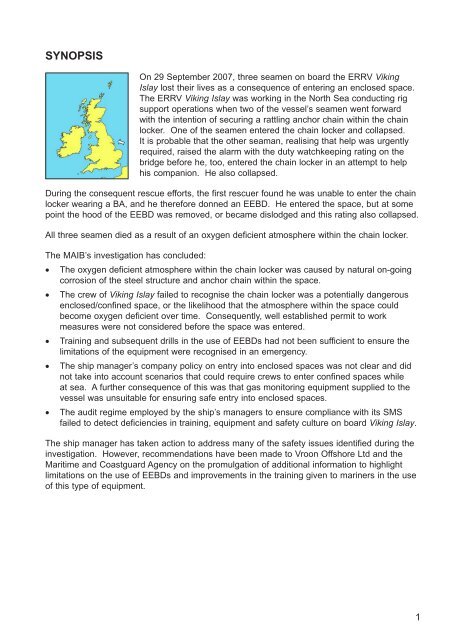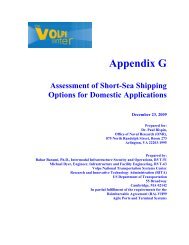ERRV Viking Islay - Marine Accident Investigation Branch
ERRV Viking Islay - Marine Accident Investigation Branch
ERRV Viking Islay - Marine Accident Investigation Branch
- No tags were found...
Create successful ePaper yourself
Turn your PDF publications into a flip-book with our unique Google optimized e-Paper software.
SYNOPSISOn 29 September 2007, three seamen on board the <strong>ERRV</strong> <strong>Viking</strong><strong>Islay</strong> lost their lives as a consequence of entering an enclosed space.The <strong>ERRV</strong> <strong>Viking</strong> <strong>Islay</strong> was working in the North Sea conducting rigsupport operations when two of the vessel’s seamen went forwardwith the intention of securing a rattling anchor chain within the chainlocker. One of the seamen entered the chain locker and collapsed.It is probable that the other seaman, realising that help was urgentlyrequired, raised the alarm with the duty watchkeeping rating on thebridge before he, too, entered the chain locker in an attempt to helphis companion. He also collapsed.During the consequent rescue efforts, the first rescuer found he was unable to enter the chainlocker wearing a BA, and he therefore donned an EEBD. He entered the space, but at somepoint the hood of the EEBD was removed, or became dislodged and this rating also collapsed.All three seamen died as a result of an oxygen deficient atmosphere within the chain locker.The MAIB’s investigation has concluded:• The oxygen deficient atmosphere within the chain locker was caused by natural on-goingcorrosion of the steel structure and anchor chain within the space.• The crew of <strong>Viking</strong> <strong>Islay</strong> failed to recognise the chain locker was a potentially dangerousenclosed/confined space, or the likelihood that the atmosphere within the space couldbecome oxygen deficient over time. Consequently, well established permit to workmeasures were not considered before the space was entered.• Training and subsequent drills in the use of EEBDs had not been sufficient to ensure thelimitations of the equipment were recognised in an emergency.• The ship manager’s company policy on entry into enclosed spaces was not clear and didnot take into account scenarios that could require crews to enter confined spaces whileat sea. A further consequence of this was that gas monitoring equipment supplied to thevessel was unsuitable for ensuring safe entry into enclosed spaces.• The audit regime employed by the ship’s managers to ensure compliance with its SMSfailed to detect deficiencies in training, equipment and safety culture on board <strong>Viking</strong> <strong>Islay</strong>.The ship manager has taken action to address many of the safety issues identified during theinvestigation. However, recommendations have been made to Vroon Offshore Ltd and theMaritime and Coastguard Agency on the promulgation of additional information to highlightlimitations on the use of EEBDs and improvements in the training given to mariners in the useof this type of equipment.1
















